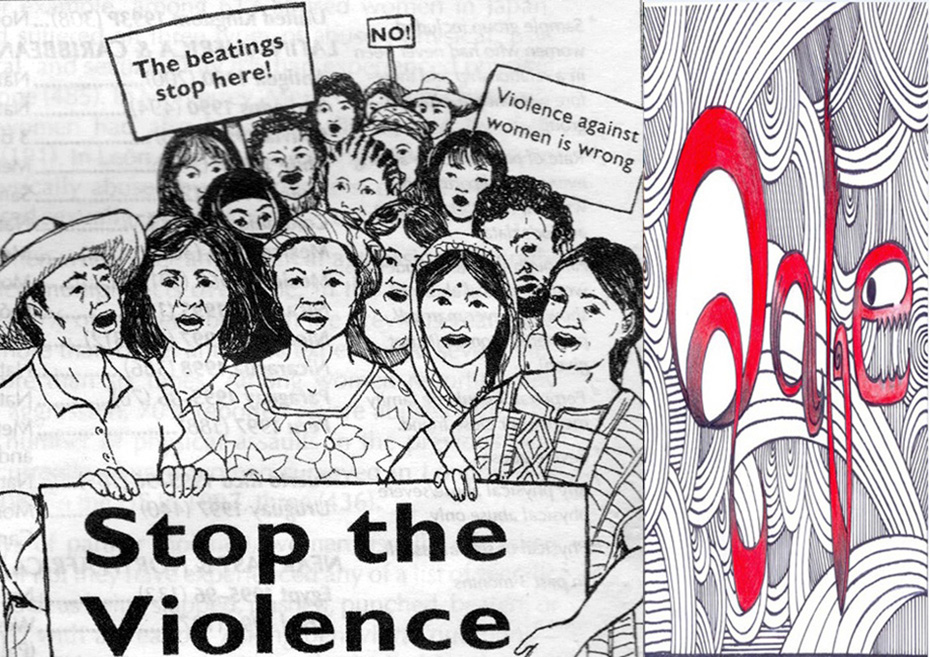Just as the International Fortnight to protest Violence Against Women winds up this year, Qafe goes back to its historical moorings. By Paramita Banerjee.
That time of the year has just ended – International Fortnight to protest Violence against Women: beginning on 25th November and culminating on 10th December, which is also observed as the International Human Rights Day. The history of 25th November as the International Day of Elimination of Violence against Women lies in the little Caribbean country called the Dominican Republic. Way back in 1960, Rafael Leonidas Trujillo had the three Mirabel sisters – Patricia, Maria Teresa and Minerva – murdered for their persistent opposition, despite repeated imprisonments, to his dictatorship. Trujillo was overthrown a year later, but the historical commemoration of the day had to wait for some 20 years. It was in 1981 that women’s rights activists across the globe decided for the first time to mark 25th November as a day to combat violence against women, as also to build up public awareness about it. It was another eighteen years later in 1999 that the United Nations General Assembly passed a resolution to mark the day as the International Day for Elimination of Violence against Women.
The 10th of December was adopted by the United Nations General Assembly as the International Human Rights Day much earlier in 1950, within two years of the Universal Declaration of Human Rights at the UN level. The purpose was to draw the attention of people across the globe to refer to this document as the standard of achievement with reference to human rights for all citizens of all nations.
The historicity of connecting the two days together and observing the entire fortnight to protest violence against women, actually 16 days to be precise, was first implemented as Sixteen Days of Activism against Gender Violence in 1991 by the Centre for Women’s Global Leadership (CWGL). Based at the Rutgers University, New Jersey, USA, CWGL was founded in 1989 by Charlotte Bunch and functions both as an academic centre and a non-governmental organisation with Special Consultative Status at the United Nations Economic and Social Council (ECOSOC). Countries across the world then gradually started observing the fortnight, with a special fillip noticed after the Fourth World Conference on Women in 1995, held in Beijing, where the Platform for Action document was adopted by 189 governments from across the globe.
Another attempt by activists in USA and Europe to draw public attention to the issue of women’s safety on roads and in public places needs to be mentioned in this connection also: the Take Back the Night or Reclaim the Night marches. Typically, a rally followed by a candle light march by women to demonstrate women’s right to walk without fear even in the dark. Initially, such marches would deliberately be restricted to women participants only, to symbolise individual women’s right to walk alone in the dark, and the capacity of women to resist fear and threat together. Later, of course, these marches were opened to male participants also: as allies in the fight against violence faced by women; as co-survivors of sexual assault; as partners of sexually assaulted women and more.
One of the earliest such marches was held in Philadelphia, USA, in October 1975, to protest the murder of Susan Alexander Speeth, a microbiologist who was walking home alone. Women participating in the International Tribunal on Crimes against Women held a Reclaim the Night march in Belgium in 1976. Women in Rome marched in the same year with candles in response to the recently published rape statistics. In April 1977, feminist activists in West Germany (the unification of East and West Germany would happen some twelve years later) had organised synchronised midnight marches across towns and cities to protest the levels of sexual harassment faced by women and to demand the right for women to walk alone without fear even in the dark. With their faces painted with women’s symbols and flaming torches in their hands, the marchers chanted in a united voice: We are not here to be looked at like cattle; we are not pieces of meat.
Activists in UK were already deeply disturbed with the slow police response to the serial killing of women (thirteen women between 1975 and 1980) by the so-called Yorkshire Ripper, later to be identified as Peter Sutcliff, Britain’s most notorious serial killer till date. The candle-lit night marches appealed to them and in 1977, Reclaim the Night marches were held in 11 towns in England. Later, these marches would often form part of the various activities implemented during the International Fortnight protesting Violence against Women. In India, the first such march was held in 1978 in Mumbai in protest against the gang rape of a pregnant woman.
Violence against women wears many faces. This qafeteer would actually go one step further and say that violence is not just against biological women, but against femininity per se, as it is defined and understood within patriarchal value systems and social perceptions. The phrase violence against women, of course, immediately suggests to us some of the more gross violations that women have to routinely face across the globe: rape and other forms of sexual assault; wife beating and bride burning; female foeticide and infanticide – to name a few. Violence against women and the feminine, however, express themselves in myriad forms varying in their degrees of subtlety. Some of them are so subtle that even women themselves do not look upon those as violence. Such subtlety and the failure to identify them as forms of violence are rooted in the patriarchal design of keeping women’s sexuality strictly under control, to deeply entrench a belief pattern that reflects such violations as normal, natural. So much so that women would sometimes inflict such violence on themselves. One could refer to Soma A Chatterji’s No Safe Place: Violence Against Women to cite a relevant example from Hindu mythology and folklores. She cites Sita’s two trials by fire; Savitri’s long arduous journey to heaven to get her dead husband back; and Gandhari’s decision to blindfold herself to face the same difficulties as her genetically blind husband as cases of self-inflicted violence. To that, I would like to add that the glorification of these very acts of these women – carried on till date through indigenous soaps and serials and movies – ensures (or, seeks to and achieves to a considerable degree) that girls in India grow up to believe in these values. That nothing is dearer to a woman than her husband and nothing is too difficult to retain his trust and/or his presence by her side.
The urge to share some anecdotes at this point is irresistible, for at times real life yarns can drive home a point better than a load of statistics. Just about a year ago, the five year old daughter of a highly educated couple was sexually abused by the conductor of her school bus. Well, certainly one of the worst forms of violence that girls across the globe have to routinely face, at times from an age even more tender. However, for me – the fact that the father, a high-ranking teacher in one of the premier educational institutes of the country, asked his wife to resign from her PhD Scholar position so that she could herself take the child to school and bring her back is also an act of violence that we do not even recognise as one. A senior IAS officer, retired by the time I had the chance to meet and work with her, had told me during the first-ever Take Back the Night march in Kolkata on 10th December, 1996 that in retrospect she felt saddened by the thought that her father, whom she had always respected as her best and primary teacher, had also been emotionally violent towards her mother. By the simple act of prohibiting his wife from taking the children with her to her parents’ house, he had effectively stopped her from going there as long as they were young. A highly educated woman, who retired as the Principal of an undergraduate college, had testified against her daughter’s right of custody over her children. Because this newly divorced woman had come out to her family as bisexual. A lesbian woman had her own elder brother organise to get her raped by a friend of his with full consent of both her parents, not to punish her, but to ‘cure’ her by ‘helping’ her to get the taste of a real man. Was this act of ‘helping’ any less violent than the rape itself?
Yes, these anecdotes are deliberately chosen, but all of them are real life stories. The point that I want to make is twofold: a) violence is often so subtle and so much a part of our accepted and practised norms of social behaviour that it is not even recognised as violence; and b) violence against girls and women is not at all restricted to families in the lower rungs of the socio-economic ladder – it is equally prevalent, maybe more in its subtler forms – among the so-called educated middle classes also. What these anecdotes also reveal is that girls and women are really not safe anywhere: not even inside their homes, within the so-called loving care of their families – though the myth that the bad girls who go everywhere at all hours of night and day get raped and murdered continue to hold strong.
Before signing off, let me just name the top ten countries in rape crimes against women: USA, South Africa, Sweden, India, UK, Germany, France, Canada, Sri Lanka and Ethiopia – in that order. So, globally also – socio-economic and technological advancement seems to have little effect on increasing the safety of girls and women. Why just a fortnight? Perhaps a march needs to be held every single day to reclaim the day and take back the night for girls and women to dress, move, behave, live without fear. Or else, girls and women will continue to be at risk simply because they are.














